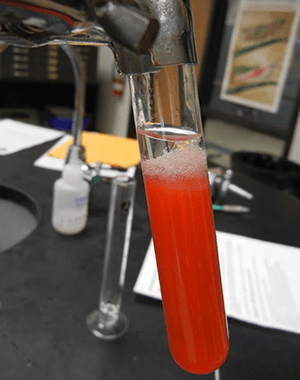
My freshman class usually does a basic strawberry DNA extraction. This is a really simple lab that can be done with minimal supplies.
Strawberries are good specimens for DNA extraction due to the following reasons:
- Easy to pulverize: Strawberries are soft and easy to pulverize, which makes it easier to extract DNA from them.
- Contain enzymes: Strawberries contain enzymes called pectinases and cellulases that help to break down cell walls, making it easier to extract DNA
- Large genomes: Strawberries have large genomes and are octoploid, meaning they have eight copies of each type of chromosome in each cell. This means there is a lot of DNA to isolate, making it easier to extract DNA from strawberries compared to other fruits.
- Yield more DNA: Strawberries yield more DNA than any other fruit, such as bananas or kiwis.
- Polar/non-polar boundary layer: The polar/non-polar boundary layer causes the DNA to precipitate, making it easier to extract.
In this version, students extract DNA from several samples and compare the amounts and appearance. Strawberries are still the best specimens, mainly because they are octoploid (they have 8 sets of chromosomes!). A close second is the kiwi, which is hexaploid and contain an impressive 174 chromosomes. In both cases, you can easily see the strands of DNA from the precipitate in either sample.
I have even done an extraction with saliva and cheek cells. This does work, but the results just aren’t as impressive as strawberry and kiwi. Another sample that works fairly well are fresh peas (buy them from the frozen food section) and bananas. You can also get beans from the supermarket, but you probably want to soak them in water the night before the lab. I usually have each group do 2-3 different extractions from the specimens provided so they get a good comparison.
Compare to a Sample without DNA
If you want a negative control and some interesting discussions, have them extra DNA from a potato. While potatoes do have DNA, most of the mass of the potato comes from the stored starch. You could also task students with extracting DNA from cooked food. This will also have sketchy results because cooking will degrade DNA.
In this advanced version, students must also answer questions about why some samples have more DNA than others, and what happens when you eat DNA. Are you what you eat??
I currently have three version of this lab for different levels. Pick the one that works for you!
- DNA Extraction (Intro bio / basic ) – has very clear step-by-step instructions
- DNA Extraction (Regular bio) – just the strawberry with basic questions
- Investigation: DNA in Different Samples – AP biology, questions are more in-depth

